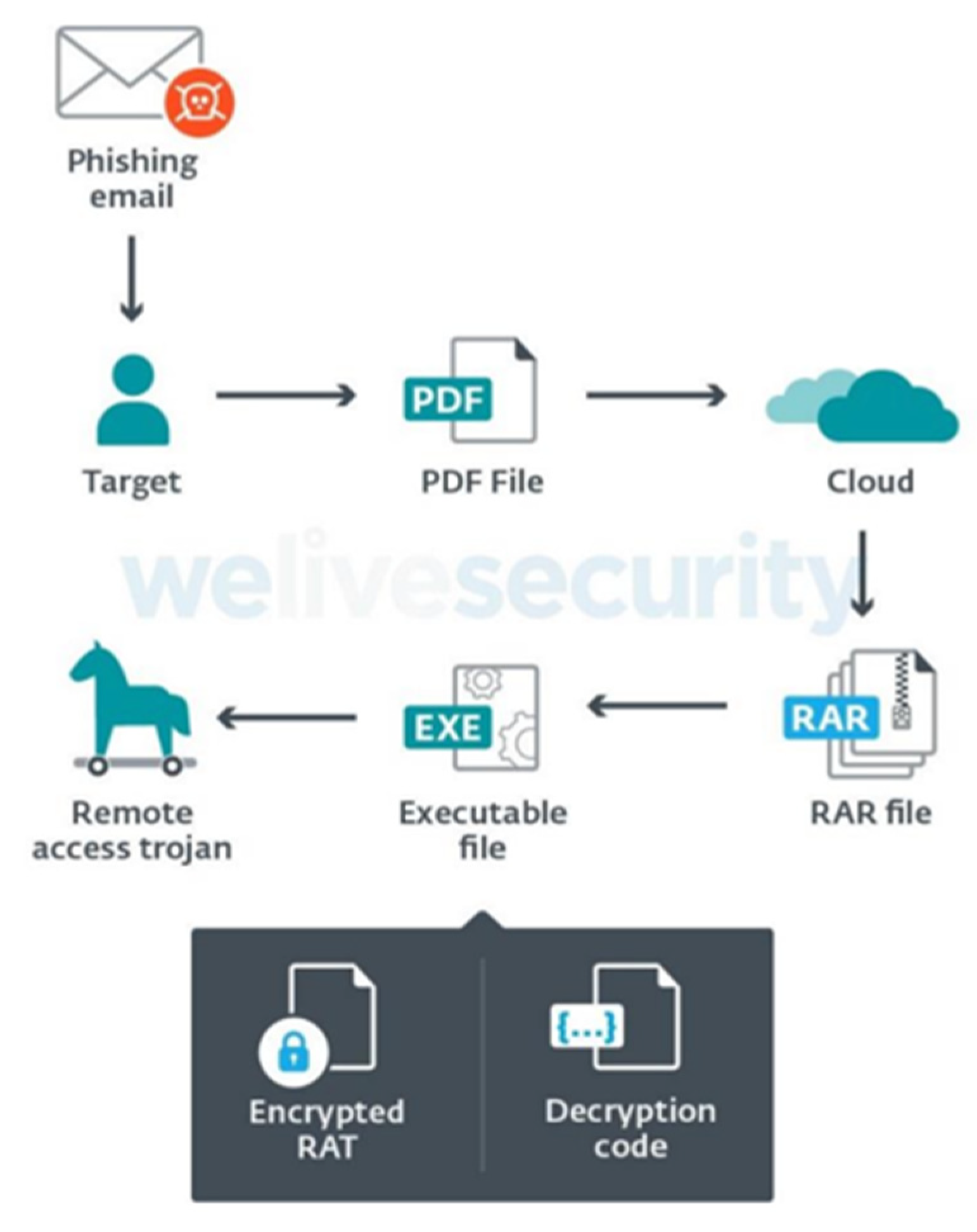Machine Learning Techniques for Cyberattack Prevention in IoT Systems: A Comparative Perspective of Cybersecurity and Cyberdefense in Colombia
Abstract
1. Introduction
- Colombia’s vulnerability to cyber-intrusions underscores the immediacy for more robust cybersecurity provisions [1]. As the nation’s IoT network experiences continue growth, the likelihood of more severe breaches intensifies, jeopardizing personal privacy and national security.
- To effectively attenuate these hazards, it is imperative for individuals, organizations, and governing authorities to engage in close cooperation towards devising comprehensive cybersecurity protocols tailored explicitly for IoT systems [1]. Unswerving vigilance and anticipatory endeavors are crucial in maintaining a strategic advantage over nefarious actors seeking to capitalize on susceptibilities within Colombia’s rapidly developing digital terrain [1].
- This document provides an explanation of the utilization of machine learning algorithms within the Internet of Things (IoT) security landscape [6]. The transparency and traceability afforded by blockchain facilitate secure and verifiable data transactions, enabling ML algorithms to operate on trustworthy datasets [7]. This synergy not only fortifies the reliability of AI-driven decisions in IoT applications but also establishes a resilient defense against potential security breaches, providing a meticulous overview of fundamental principles and key attributes technology, elucidating how these features can be strategically harnessed to augment the capabilities of AI in application issues.
- In general, each cyber-attack has a solution that improves the impact on the economy [8] and the introduction of good practices for globalization change:
- Symbiotic integration for decentralized economies: Delving into the synergistic potential of integrating AI and blockchain [9], elucidating how this union could cultivate a novel ecosystem characterized by decentralized economic structures. Additionally, outlining the inherent benefits derived from this transformative integration.
- Comprehensive taxonomy of IoT ecosystem: Offering a meticulous taxonomy encompassing diverse dimensions, including blockchain platforms, architectural frameworks, infrastructure typologies, and consensus protocols. This taxonomy is complemented by an exploration of existing applications of decentralized AI within this comprehensive framework.
- Examination of practical applications: Presenting a thorough examination and discussion of multiple practical use cases wherein AI applications leverage blockchain technology across various vertical domains.
2. Background and Relative Work
2.1. APT Comparison and Actual Perspective
- Computers in general;
- Network nodes;
- Mobile devices;
- Wearable items;
- Video games;
- Home automation items;
- Storage devices;
- Surveillance items;
- Work devices;
- Domestic virtual assistants;
- Cars;
- Media and TV items;
- Appliances examples;
- Other generic items.
2.2. Common Systems Behavioral (CSB) Sources Used for Attack Detection
- (APT-C-36) [34] “Attackers coming from South America carried out continuous targeted attacks against Colombian government institutions as well as important corporations in financial sector, petroleum industry, professional manufacturing”, as per the Spalax Operation in 2021 with a RAT (remote-access Trojan) scuh as: Remcos, njRAT, AsyncRAT, and others (see Figure 2).
- Alerts instances correlation:
- -
- Alert instances filters.
- -
- Alert instances clustering.
- -
- APT attack scenario.
- Victim–host IP
- -
- Preliminary correlation.
- -
- Log instances community detection.
2.3. APT and Cyberattacks Detection (ML) and (CPS) Approaches
- -
- Anomaly detection: [7,13]: Construct a taxonomy [23] or ontology [28] based [18] correlation (Table 1) and convert a BE (behavioral execution) in an input coordinated with a CSB detected. The inclusion analyzes the interrelationships of machine learning use in cybersecurity and CPS [13], e.g., virtual MAC spoofing detection [39].
- -
- Misuse detection: The second dataset is the distance from the data to the nearest neighbor within the cluster or CPS (correlated). Furthermore, the approach rebuilds the data features by using the distances, and formats the data features as logistic regression, naïve Bayes, perceptron, and k-nearest neighbor (k-NN) classifier.
3. Methodology and Research
3.1. OODA-Diamond-CKC and TTPs Methodology
3.2. Diamond Model [48]
- -
- Actor analysis: Identify threat actors involved in APTs against IoT systems.
- -
- Capability analysis: Assess the capabilities of threat actors [49] in exploiting IoT vulnerabilities.
- -
- Infrastructure analysis: Investigate the infrastructure utilized by threat actors in IoT-related APTs.
- -
- Victimology analysis: Understand the targeted entities and motives behind IoT APTs.
3.3. OODA Loop [47]
- -
- Observe: Collect real-time data on IoT network activities and potential security events.
- -
- Orient: Analyze collected data to discern patterns, anomalies, and potential indicators of APTs.
- -
- Decide: Formulate decisions based on the analysis, prioritizing potential threats [20].
- -
- Act: Implement proactive and responsive measures against identified threats in the IoT ecosystem.
3.4. Cyber Kill Chain [50]
- -
- Reconnaissance: Identify reconnaissance activities targeting IoT systems.
- -
- Weaponization: Analyze the development and deployment of malicious tools tailored for IoT APTs.
- -
- Delivery: Investigate methods employed for delivering malicious payloads to IoT devices.
- -
- Exploitation: Assess the exploitation of vulnerabilities in IoT devices to establish persistence.
- -
- Installation: Examine the installation of APT [18] components within IoT systems.
- -
- Command and control: Analyze the establishment of communication channels between threat actors and compromised IoT devices.
- -
- Actions on objectives: Understand the final objectives and impact of APTs on IoT ecosystems.
3.5. TTPs Attack Patterns [51]
- -
- Investigate tactics, techniques, and procedures [52] employed by threat actors in executing APTs against IoT environments.
- -
- Classify TTPs based on specific attack patterns observed in IoT-related incidents or based on external information of external data sources [27].
3.6. Select a Combination Methodology
- Alert and detection process: This method is oriented with a commentary on different positions on PSCs and protection devices, an example related to the defense of PSCs against an eventual attack affecting their availability and integrity.
- The second process is the identification and analysis of the characteristics indicated in Figure 5, which identifies the actual identification, assessment, and capability aspects of the threat actor.
- The relationship of the two previous parts regarding the selection of variables to determine the impact that the threat could generate in Colombia, considering the comparison in perspective related to the CPS.
3.7. Attack Evaluation Patterns and Select Data Sources
System Layers and Vulnerabilities
- -
- The four layers of a system—applications, services, OS and kernel, and hypervisor—are explored, emphasizing their significance in both traditional IoT and cloud environments.
- -
- Application categories, including browsers, Microsoft Office, and Adobe programs, play pivotal roles in the system’s vulnerability landscape.
- -
- Services, such as the server message block (SMB) and the remote desktop protocol (RDP), represent external functionalities and are potential targets for attacks.
- -
- Operating system and kernel levels are consistently targeted, underscoring the need for robust defensive measures.
- -
- Memory corruption techniques:
- -
- Memory corruption is a prevalent category of vulnerabilities, encompassing techniques such as buffer overflow (BOF), heap overflow (HOF), and integer overflow.
- -
- Various mitigation techniques, such as data execution prevention (DEP) in Windows and the no-execute (NX) bit, aim to safeguard against the execution of malicious shell code in the stack area.
3.8. Adjustable Supervised ML Models (Categorical Variables [63])
3.9. Handling Categorical Variables and Data Times
3.10. Feature Selection (CVSS [66]-APT Associate)
3.11. Creation of Derived Features
3.12. Training and Testing Models
4. Precision of Data Frame and Accuracy Tasks
4.1. Precision, Recall, and F1 Score (Separated)
- Precision, or positive predictive value (PPV):
- -
- Precision (Figure 10) is defined as the proportion of accurately predicted positive instances relative to the total instances predicted as positive. In the given context, a precision value of 0.25 indicates that only 25% of instances predicted as positive were correctly identified as true positives.
- Recall, or sensitivity/true positive rate (TPR):
- -
- Recall (Figure 10) represents the ratio of accurately predicted positive instances to the total number of actual positive instances. A recall value of 0.25 implies that the model successfully captured only 25% of all positive instances.
- F1 Score:
- -
- The F1 score (Figure 10) is the harmonic mean of precision and recall, offering a balanced evaluation that accounts for both false positives and false negatives. With an F1 score of 0.25, the model attains a moderate equilibrium between precision and recall, reflecting a trade-off between these two metrics.
4.2. Application of Algorithms and Results
- Accuracy
- Precision, Recall, and F1 score:
- 1.
- Random forest:
- Precision: 0.1707.
- Recall: 0.275.
- F1 Score: 0.2038.
- Interpretation: The model exhibits low precision, capturing only a small proportion of true positive predictions. However, it achieves a balance between precision and recall (excluded).
- 2.
- Logistic regression:
- Precision: 0.3898.
- Recall: 0.325.
- F1 Score: 0.3418.
- Interpretation: The model demonstrates moderate precision and recall, striking a balance between each one.
- 3.
- Naïve Bayes:
- Precision: 0.3057.
- Recall: 0.275.
- F1 Score: 0.2589.
- Interpretation: The model exhibits moderate precision and recall, with a trade-off between each one.
- 4.
- Perceptron:
- Precision: 0.4086.
- Recall: 0.35.
- F1 Score: 0.3658.
- Interpretation: The model achieves a relatively higher precision and recall, demonstrating balanced performance.
- 5.
- k-NN:
- Precision: 0.3144.
- Recall: 0.275.
- F1 Score: 0.27.
- Interpretation: The model exhibits moderate precision, capturing a moderate proportion of true positive predictions with a trade-off between precision and recall.
4.2.1. Logistic Regression (RL) Validation
4.2.2. Naïve Bayes Confrontation
4.2.3. Perceptron Relations
4.2.4. K-Nearest (k-NN) Analyses and Results
5. Conclusions and Limitations
Limitations
Author Contributions
Funding
Data Availability Statement
Conflicts of Interest
References
- Parra, D.T.; Talero-Sarmiento, L.H.; Ortiz, J.D.; Guerrero, C.D. Technology readiness for IoT adoption in Colombian SMEs. In Proceedings of the 2021 16th Iberian Conference on Information Systems and Technologies (CISTI), Chaves, Portugal, 23–26 June 2021; pp. 1–6. [Google Scholar] [CrossRef]
- Russell, B. IoT Cyber Security. In Intelligent Internet of Things: From Device to Fog and Cloud; Springer: Berlin/Heidelberg, Germany, 2019; pp. 473–512. [Google Scholar] [CrossRef]
- Seifousadati, A.; Ghasemshirazi, S.; Fathian, M. A Machine Learning Approach for DDoS Detection on IoT Devices. arXiv 2021, arXiv:2110.14911. [Google Scholar]
- Pokhrel, S.; Abbas, R.; Aryal, B. IoT Security: Botnet detection in IoT using Machine learning. arXiv 2021, arXiv:2104.02231. [Google Scholar]
- Hassija, V.; Chamola, V.; Saxena, V.; Jain, D.; Goyal, P.; Sikdar, B. A Survey on IoT Security: Application Areas, Security Threats, and Solution Architectures. IEEE Access 2019, 7, 82721–82743. [Google Scholar] [CrossRef]
- Jain, V.K.; Gajrani, J. IoT Security: A Survey of Issues, Attacks and Defences. In Proceedings of the Intelligent Learning for Computer Vision: Proceedings of Congress on Intelligent Systems, New Delhi, India, 5–6 September 2020; pp. 219–236. [CrossRef]
- Xiao, L.; Wan, X.; Lu, X.; Zhang, Y.; Wu, D. IoT Security Techniques Based on Machine Learning: How do IoT devices use AI to enhance security? IEEE Signal Process. Mag. 2018, 35, 41–49. [Google Scholar] [CrossRef]
- Dodda, R.; Gaddam, V.; Prasad, J.R.; Rao, B.V. The Evolution of Internet Of Things (IOT) And Its Impact on Existing Technology. Int. J. Sci. Technol. Eng. 2016, 2, 96–103. [Google Scholar]
- Pennino, D.; Pizzonia, M.; Vitaletti, A.; Zecchini, M. Blockchain as IoT Economy Enabler: A Review of Architectural Aspects. J. Sens. Actuator Netw. 2022, 11, 20. [Google Scholar] [CrossRef]
- An, Y.; Yu, F.R.; Li, J.; Chen, J.; Leung, V.C. Edge Intelligence (EI)-Enabled HTTP Anomaly Detection Framework for the Internet of Things (IoT). IEEE Internet Things J. 2020, 8, 3554–3566. [Google Scholar] [CrossRef]
- Chatterjee, A.; Ahmed, B.S. IoT Anomaly Detection Methods and Applications: A Survey. Internet Things 2022, 19, 100568. [Google Scholar] [CrossRef]
- Liang, F.; Hatcher, W.G.; Liao, W.; Gao, W.; Yu, W. Machine Learning for Security and the Internet of Things: The Good, the Bad, and the Ugly. IEEE Access 2019, 7, 158126–158147. [Google Scholar] [CrossRef]
- Bharati, S.; Podder, P. Machine and Deep Learning for IoT Security and Privacy: Applications, Challenges, and Future Directions. arXiv 2022, arXiv:2210.13547. [Google Scholar] [CrossRef]
- Rashid, M.M.; Kamruzzaman, J.; Imam, T.; Kaisar, S.; Alam, M.J. Cyber Attacks Detection from Smart City Applications Using Artificial Neural Network. In Proceedings of the Asia-Pacific Conference on Computer Science and Data Engineering (CSDE), Gold Coast, Australia, 16–18 December 2020; pp. 1–6. [Google Scholar] [CrossRef]
- Chierzi, V.; Mercês, F. Evolution of IoT Linux Malware: A MITRE ATT&CK TTP Based Approach. In Proceedings of the 2021 APWG Symposium on Electronic Crime Research (eCrime), Boston, MA, USA, 1–3 December 2021; pp. 1–11. [Google Scholar]
- Kolias, C.; Kambourakis, G.; Stavrou, A.; Voas, J.M. DDoS in the IoT: Mirai and Other Botnets. Computer 2017, 50, 80–84. [Google Scholar] [CrossRef]
- Friedberg, I.; Skopik, F.; Settanni, G.; Fiedler, R. Combating Advanced Persistent Threats: From Network Event Correlation to Incident Detection. Comput. Secur. 2015, 48, 35–57. [Google Scholar] [CrossRef]
- Kharchenko, V.; Sklyar, V. ENISA Documents in Cybersecurity Assurance for Industry 4.0: IIoT Threats and Attacks Scenarios. In Proceedings of the 2019 10th IEEE International Conference on Intelligent Data Acquisition and Advanced Computing Systems, Metz, France, 18–21 September 2019; Volume 2, pp. 1046–1049. [Google Scholar]
- Tsakalidis, G.; Vergidis, K.; Madas, M. Decision and Information Technologies (CoDIT)—Cybercrime Offences: Identification, Classification and Adaptive Response. In Proceedings of the 2018 5th International Conference on Control, Decision and Information Technologies (CoDIT), Thessaloniki, Greece, 10–13 April 2018; pp. 470–475. [Google Scholar] [CrossRef]
- da Rocha, B.C.; de Melo, L.P.; de Sousa, R.T., Jr. A Study on APT in IoT Networks. In Proceedings of the 18th International Conference on e-Business (ICE-B 2021), Nanjing, China, 3–7 December 2021. [Google Scholar]
- Stellios, I.; Kotzanikolaou, P.; Psarakis, M.; Alcaraz, C.; López, J. A Survey of IoT-Enabled Cyberattacks: Assessing Attack Paths to Critical Infrastructures and Services. IEEE Commun. Surv. Tutor. 2018, 20, 3453–3495. [Google Scholar] [CrossRef]
- NIST. Guide to Operational Technology (OT) Security; NIST: Gaithersburg, MD, USA, 2023. [Google Scholar]
- Available online: https://nvlpubs.nist.gov/nistpubs/SpecialPublications/NIST.SP.800-82r3.pdf (accessed on 1 January 2024).
- Bertino, E.; Islam, N. Botnets and Internet of Things Security. Computer 2017, 50, 76–79. [Google Scholar] [CrossRef]
- Cheng, X.; Zhang, J.; Chen, B. Cyber Situation Comprehension for IoT Systems Based on APT Alerts and Logs Correlation. Sensors 2019, 19, 4045. [Google Scholar] [CrossRef] [PubMed]
- Singh, T.; Jabar, M.M. Exploration of Mobile Device Behavior for Mitigating Advanced Persistent Threats (APT): A Systematic Literature Review and Conceptual Framework. Sensors 2022, 22, 4662. [Google Scholar]
- Kim, G.; Choi, C.; Choi, J. Ontology modeling for APT attack detection in an IoT-based power system. In Proceedings of the 2018 Conference on Research in Adaptive and Convergent Systems—RACS ’18, Adaptive and Convergent Systems (RACS), Honolulu, HI, USA, 9–12 October 2018; pp. 160–164. [Google Scholar] [CrossRef]
- OMDIA. 01 de Diciembre de 2023. 5G Forecast 2023–2028. 2023. Available online: https://www.5gamericas.org/resources/charts-statistics/latin-america/ (accessed on 1 January 2024).
- Barrios, A.; Cama, D.; Mardini, J.; Díaz, J. Projections of IoT Applications in Colombia Using 5G Wireless Networks. Sensors 2021, 21, 7167. [Google Scholar] [CrossRef] [PubMed]
- (TicTac), ICT Analysis and Creativity Tank. AI for Protection and Threat Prevention. 2023. Available online: https://www.ccit.org.co/estudios/estudio-anual-de-ciberseguridad-2022-2023/ (accessed on 1 January 2024).
- Kaspersky, «Impacto TIC» 25 01 2024. [En línea]. Available online: https://impactotic.co/tecnologia/157-000-ciberataques-diarios-en-colombia-en-el-2023/ (accessed on 30 January 2024).
- QiAnXin Threat Intelligence Center 2023. Available online: https://ti.qianxin.com/blog/articles/apt-c-36-continuous-attacks-targeting-colombian-government-institutions-and-corporations-en/ (accessed on 1 January 2024).
- Malpedia. 2023. Available online: https://malpedia.caad.fkie.fraunhofer.de/actor/apt-c-36 (accessed on 1 January 2024).
- ESET WeliveSecurity. 2021. Available online: https://www.welivesecurity.com (accessed on 1 January 2024).
- Available online: https://www.welivesecurity.com/2021/01/12/operation-spalax-targeted-malware-attacks-colombia/ (accessed on 1 January 2024).
- Javed, S.H.; Ahmad, M.B.; Asif, M.; Almotiri, S.H.; Masood, K.; Ghamdi, M.A.A. An Intelligent System to Detect Advanced Persistent Threats in Industrial Internet of Things (I-IoT). Electronics 2022, 11, 742. [Google Scholar] [CrossRef]
- Ma, Z.; Li, Q.; Meng, X. Discovering Suspicious APT Families Through a Large-Scale Domain Graph in Information-Centric IoT. IEEE Access 2019, 7, 13917–13926. [Google Scholar] [CrossRef]
- Al-Kadhimi, A.A.; Singh, M.M.; Jabar, T. Fingerprint for Mobile-Sensor APT Detection Framework (FORMAP) Based on Tactics Techniques and Procedures (TTP) and Mitre. In Proceedings of the 8th International Conference on Computational Science and Technology: ICCST 2021, Labuan, Malaysia, 28–29 August 2022; Springer: Singapore, 2022; pp. 515–533. [Google Scholar]
- Jiang, P.; Wu, H.; Wang, C. Virtual MAC Spoofing Detection Through Deep Learning. In Proceedings of the 2018 IEEE International Conference on Communications (ICC), Kansas City, MO, USA, 20–24 May 2018; pp. 1–6. [Google Scholar]
- Pelletier, C.; Webb, G.I.; Petitjean, F. Deep learning for the classification of Sentinel-2 image time series. In Proceedings of the IGARSS 2019-2019 IEEE International Geoscience and Remote Sensing Symposium, Yokohama, Japan, 28 July–2 August 2019. [Google Scholar]
- Dong, S.; Xia, Y.; Peng, T. Network abnormal traffic detection model based on semi-supervised deep reinforcement learning. IEEE Trans. Netw. Serv. Manag. 2021, 18, 4197–4212. [Google Scholar] [CrossRef]
- Di Mauro, M.; Galatro, G.; Liotta, A. Experimental review of neural-based approaches for network intrusion management. IEEE Trans. Netw. Serv. Manag. 2020, 17, 2480–2495. [Google Scholar] [CrossRef]
- Ahanger, T.A. Defense Scheme to Protect IoT from Cyber Attacks Using AI Principles. Int. J. Comput. Commun. Control 2018, 13, 915–926. [Google Scholar] [CrossRef]
- Kuzlu, M.; Fair, C.; Guler, O. Role of Artificial Intelligence in the Internet of Things (IoT) Cybersecurity. Discov. Internet Things 2021, 1, 7. [Google Scholar] [CrossRef]
- Li, S.; Zhang, Q.; Wu, X.; Han, W.; Tian, Z. Attribution Classification Method of APT Malware in IoT Using Machine Learning Techniques. Secur. Commun. Netw. 2021, 2021, 9396141. [Google Scholar] [CrossRef]
- Raschaka, S.; Mirjalili, V. Python Mavhine Learning, 1st ed.; Marcombo: Barcelona, Spain, 2019; ISBN 978-84-267-2720. [Google Scholar]
- Hämäläinen, T.; Bodström, T. A Novel Method for Detecting APT Attacks by Using OODA Loop and Black Swan Theory. In Proceedings of the Computational Data and Social Networks: 7th International Conference, CSoNet 2018, Shanghai, China, 18–20 December 2018; Proceedings 7. Springer International Publishing: Berlin/Heidelberg, Germany, 2018; pp. 498–509. [Google Scholar]
- Caltagirone, S.; Pendergast, A.; Betz, C. The Diamond Model of Intrusion Analysis. Threat Connect 2013, 298, 1–61. [Google Scholar]
- Choi, J.J.; Choi, C.; Lynn, H.M.; Kim, P. Ontology-Based APT Attack Behavior Analysis in Cloud Computing. In Proceedings of the 2015 10th International Conference on Broadband and Wireless Computing, Communication and Applications (BWCCA), Krakow, Poland, 4–6 November 2015; IEEE: Piscataway, NJ, USA, 2015; pp. 375–379. [Google Scholar]
- Mohsin, M.; Anwar, Z. Where to Kill the Cyber Kill-Chain: An Ontology-Driven Framework for IoT Security Analytics. In Proceedings of the 2016 International Conference on Frontiers of Information Technology (FIT), Islamabad, Pakistan, 19–21 December 2016; pp. 23–28. [Google Scholar] [CrossRef]
- Noor, U.; Shahid, S.; Kanwal, R.; Rashid, Z. A Machine Learning Based Empirical Evaluation of Cyber Threat Actors High-Level Attack Patterns over Low-Level Attack Patterns in Attributing Attacks. arXiv 2023, arXiv:2307.10252. [Google Scholar]
- Kim, K.; Alfouzan, F.A.; Kim, H.K. Cyber-Attack Scoring Model Based on the Offensive Cybersecurity Framework. Appl. Sci. 2021, 11, 7738. [Google Scholar] [CrossRef]
- ElKashlan, M.; Aslan, H.; Azer, M.A. DDoS Attack Detection in IoT Using Machine Learning-Based Intrusion Detection System (IDS). In Proceedings of the 2022 18th International Computer Engineering Conference (ICENCO), Cairo, Egypt, 28–29 December 2022; pp. 19–24. [Google Scholar]
- Ngo, M.V.; Luo, T.; Chaouchi, H.; Quek, T.Q. Contextual-Bandit Anomaly Detection for IoT Data in Distributed Hierarchical Edge Computing. In Proceedings of the 2020 IEEE 40th International Conference on Distributed Computing Systems (ICDCS), Singapore, 29 November–1 December 2020; pp. 1227–1230. [Google Scholar]
- Xia, Q.; Dong, S.; Peng, T. An Abnormal Traffic Detection Method for IoT Devices Based on Federated Learning and Depthwise Separable Convolutional Neural Networks. In Proceedings of the 2022 IEEE International Performance, Computing, and Communications Conference (IPCCC), Austin, TX, USA, 11–13 November 2022; IEEE: Piscataway, NJ, USA, 2022. [Google Scholar]
- Open Data of General Prosecutor’s Office of the Nation 2019–2023. Available online: https://www.datos.gov.co/browse?q=fiscalia%20spoa&sortBy=relevance/ (accessed on 12 January 2024).
- Ghafir, V.; Prenosil, V.; Hammoudeh, M.; Aparicio-Navarro, F.J.; Rabie, K.; Jabban, A. Disguised Executable Files in Spear-Phishing Emails: Detecting the Point of Entry in Advanced Persistent Threat. In Proceedings of the 2nd International Conference on Future Networks and Distributed Systems, Amman, Jordan, 26–27 June 2018; pp. 1–5. [Google Scholar]
- ThreatMon. APT Blind Eagle’s Malware Arsenal: Technical Analysis of the New Attack Chain; TMRansommonitor, Vancouver: Sterling, TX, USA.
- Available online: https://www.shodan.io/ (accessed on 1 January 2024).
- Available online: https://www.zoomeye.org/ (accessed on 1 January 2024).
- exploit-db. Available online: https://www.exploit-db.com/ (accessed on 1 January 2024).
- packetstormsecurity.com. Available online: https://packetstormsecurity.com/ (accessed on 1 January 2024).
- Lysenko, S.; Bobrovnikova, K.; Kharchenko, V.; Savenko, O. IoT Multi-Vector Cyberattack Detection Based on Machine Learning Algorithms: Traffic Features Analysis, Experiments, and Efficiency. Algorithms 2022, 15, 239. [Google Scholar] [CrossRef]
- MISP. MISP Project. Available online: https://github.com/MISP (accessed on 1 January 2024).
- Bout, E.; Loscrí, V.; Gallais, A. How Machine Learning Changes the Nature of Cyberattacks on IoT Networks: A Survey. IEEE Commun. Surv. Tutor. 2022, 24, 248–279. [Google Scholar] [CrossRef]
- CVSS, NIST–CVS-. Available online: https://nvd.nist.gov/Vulnerability-Metrics/Calculator-Product-Integration (accessed on 1 January 2024).
- Turber, S.; Vom Brocke, J.; Gassmann, O.; Fleisch, E. Designing Business Models in the Era of Internet of Things: Towards a Reference Framework. In Proceedings of the 9th International Conference on Advancing the Impact of Design Science: Moving from Theory to Practice, (DESRIST 2014), Miami, FL, USA, 22–24 May 2014; Springer International Publishing: Berlin/Heidelberg, Germany, 2014; Volume 9, pp. 17–31. [Google Scholar]
- McKinsey. Making Sense of Internet of Things Platforms. Available online: https://www.mckinsey.com/capabilities/mckinsey-digital/our-insights/making-sense-of-internet-of-things-platforms (accessed on 1 January 2024).
- Joyanes, L. Internet of the Things; AlphaEditoria: Madrid, Spain, 2021. [Google Scholar]
- Nitin, G.; Shashank, M.; Hima, P.; Satoshi, M.; Naveen, P.; Sambaran, B.; Sameep, M.; Shanmukha, C.; Guttula, S.; Afzal, R.; et al. Data Quality for Machine Learning Tasks. In Proceedings of the 27th ACM SIGKDD Conference on Knowledge Discovery & Data Mining, Virtual Event, 14–18 August 2021; pp. 4040–4041. [Google Scholar] [CrossRef]
- Raschka, S.; Mirjalili, V. Machine Learning and Deep Learning with Python, Scikit-Learn and TensorFlow; Packt Publishing: Birmingham, UK, 2017; ISBN 9781787125933. [Google Scholar]
- Sarker, I.H. IntruDTree: A Machine Learning-Based Cyber Security Intrusion Detection Model. Symmetry 2020, 12, 754. [Google Scholar] [CrossRef]
- Huang, Y. Network Intrusion Detection Method Based on Naive Bayes Algorithm. In Proceedings of the 2022 6th Asian Conference on Artificial Intelligence Technology (ACAIT) IEEE, Changzhou, China, 4–6 November 2022; pp. 1–10. [Google Scholar] [CrossRef]
- Dong, S.; Li, R. Traffic identification method based on multiple probabilistic neural network model. Neural Comput. Appl. 2019, 31, 473–487. [Google Scholar] [CrossRef]
- Naeem, H.; Cheng, X.; Ullah, F.; Jabbar, S.; Dong, S. A Deep Convolutional Neural Network Stacked Ensemble for Malware Threat Classification in Internet of Things. J. Circuits Syst. Comput. 2022, 31, 2250302. [Google Scholar] [CrossRef]
- Ori, N.; Ayellet, T. k-NNN: Nearest Neighbors of Neighbors for Anomaly Detection. In Proceedings of the IEEE/CVF Winter Conference on Applications of Computer Vision (WACV) Workshops, Waikoloa, HI, USA, 4–8 January 2024. [Google Scholar]
- Dong, S.; Su, H.; Xia, Y.; Zhu, F.; Hu, X.; Wang, B. A Comprehensive Survey on Authentication and Attack Detection Schemes That Threaten It in Vehicular Ad-Hoc Networks. IEEE Trans. Intell. Transp. Syst. 2023, 24, 13573–13602. [Google Scholar] [CrossRef]
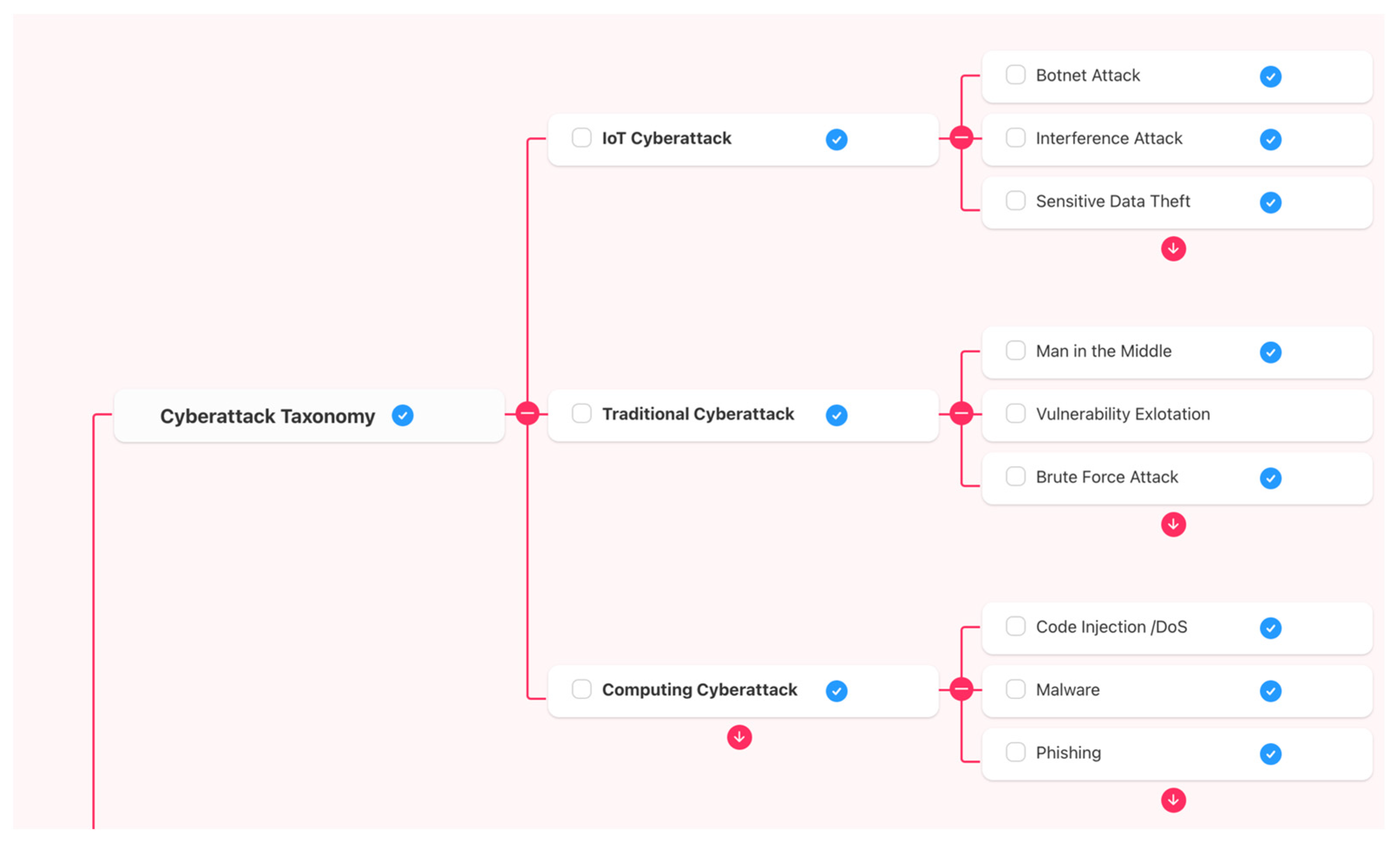

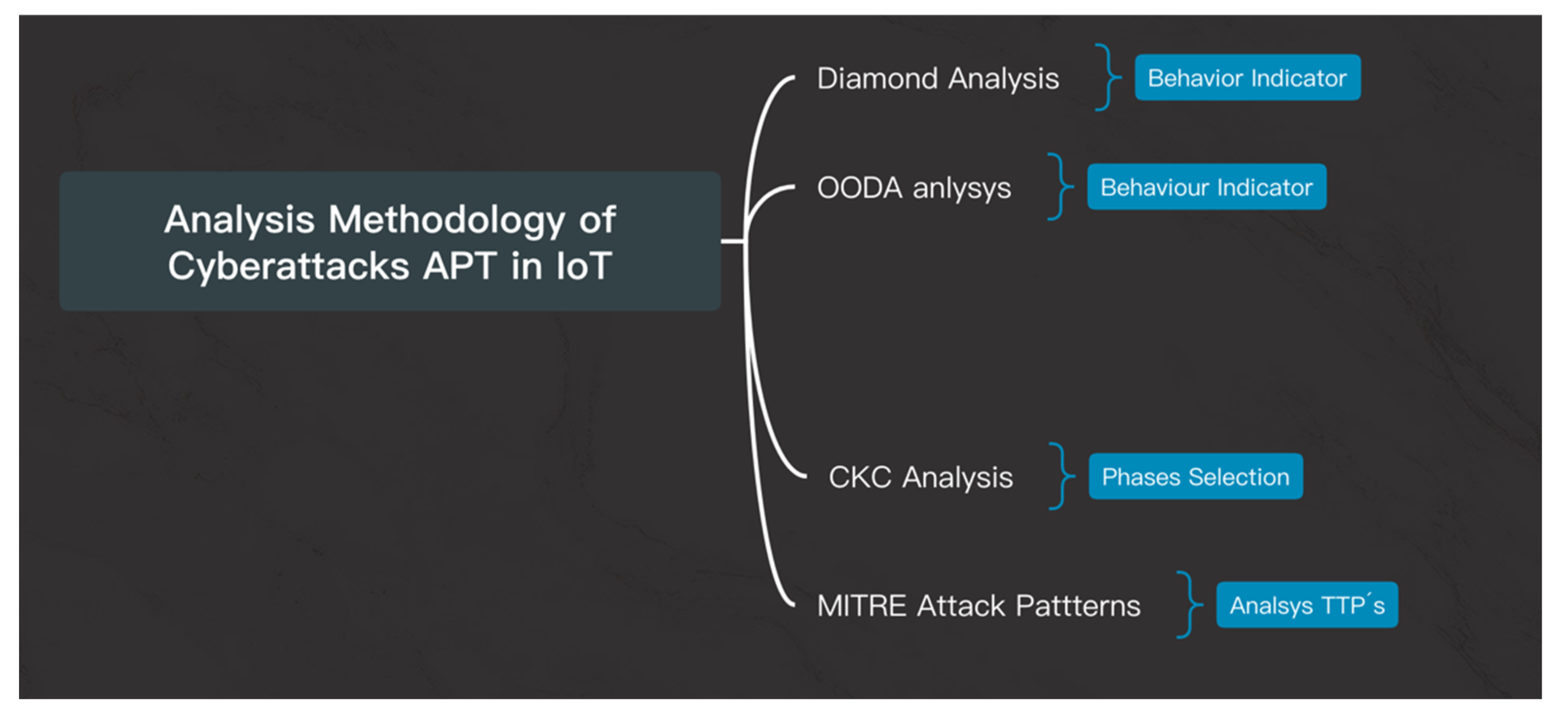
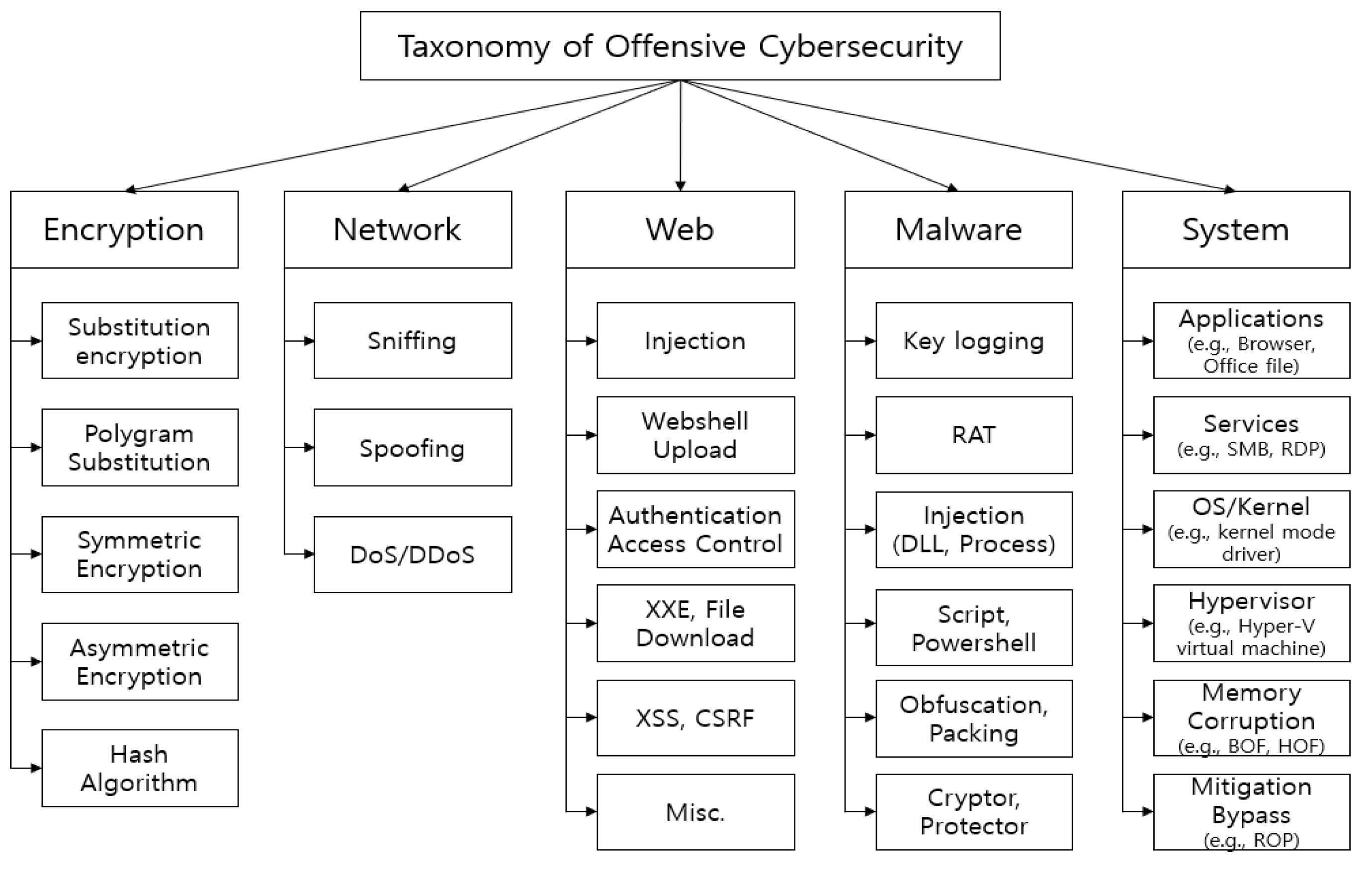



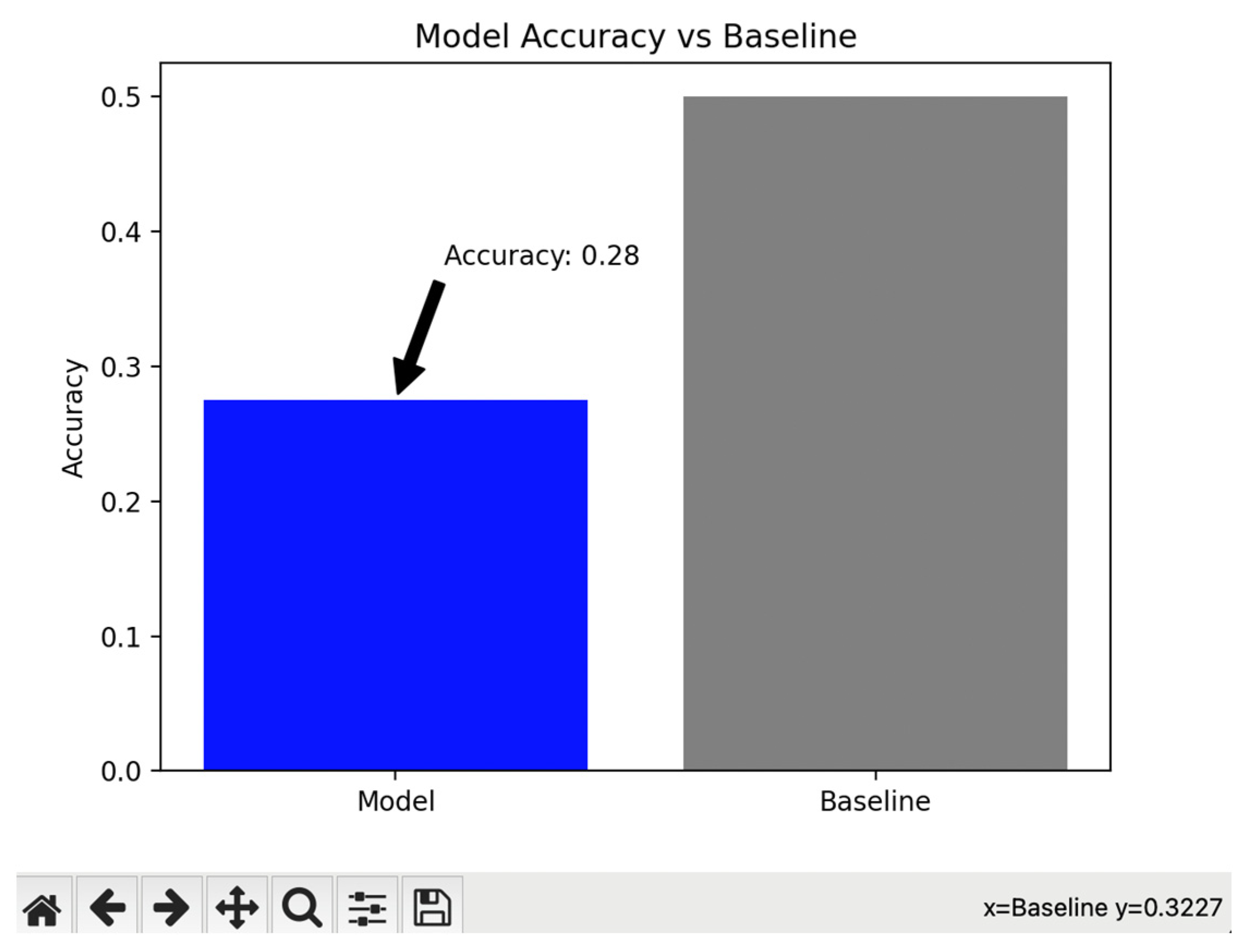

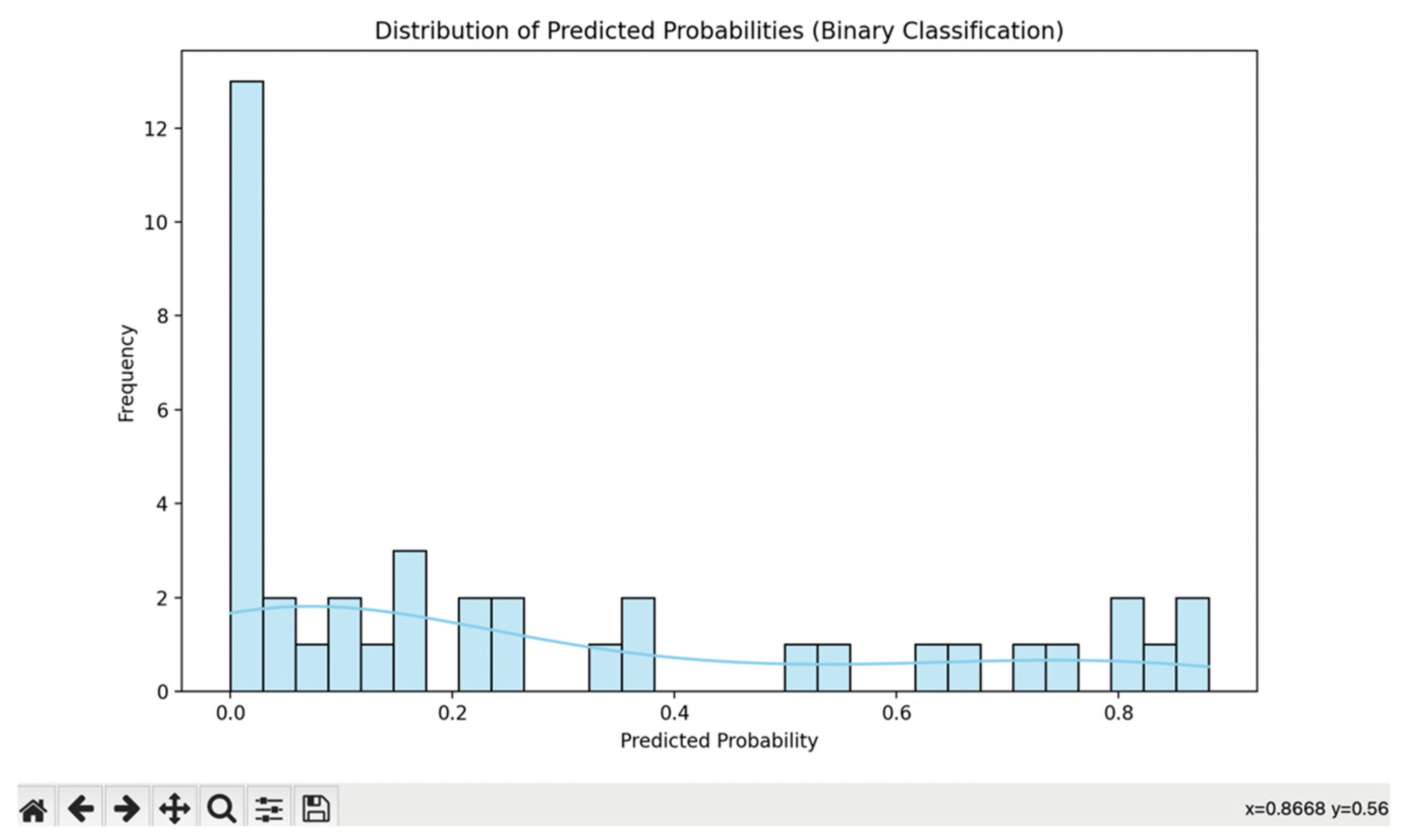



| Number | Attributes | Description |
|---|---|---|
| 1 | Timestamp | The time the alert occurs. |
| 2 | Alert_Type | The type of alert. |
| 3 | Src_Ip | The source IP of the attack step. |
| 4 | Dest_Ip | The destination IP of the attack step. |
| 5 | Src_Port | The source port number of the attack step. |
| 6 | Dest_Port | The destination port number of the attack step. |
| 7 | Victim_HostIp | The IP of the host victimized by the attack step. |
| 8 | APT type (associate) | The CSB detected (1). |
| Classic attack | ||
| 9 | TTP associate | The CSB detected (2). |
| 10 | Vector associate | The CSB detected (3). |
| 11 | Actor associate | The CSB detected (4). |
| 12 | Purpose associate | The CSB detected (5). |
| 13 | APT attribution |
| Phases MITRE ATT&CK | DM/OODA/CKC/APT |
|---|---|
| Execution | PowerShell, scripting. |
| Persistence | Registry run keys, scheduled task, new service. |
| Privilege escalation | Process injection, exploit, access token manipulation, new service. |
| Defense evasion | Hidden files, modify registry, permission modify, process injection, packing, deletion, obfuscate, masquerade, de-obfuscate, disable tools, Mshta, Indicator rm, SandBox evasion. |
| Credential access | Credential dumping, brute force, credential in files, Pass the hash. |
| Hash lateral movement | WA Share, exploit remote, remote file copy. |
| Command and control | Common ports, multilayer encryption, remote file copy, uncommon ports, data encoding, Data obfuscation. |
| Exfiltration | Automated over alt. protocol, data encrypted, over C&C impact disk, encrypt data. |
| Total Source IP Addresses | Total IP Addresses Targeted | Command and Control Communications | Origin Ports | Port Destination | Malware Families | IoT Attacked | Vulnerable Devices |
|---|---|---|---|---|---|---|---|
| 32.434 | 198.434 | 160.834 | 49.123 | 28.343 | 10 | 350 | 9.570 |
Disclaimer/Publisher’s Note: The statements, opinions and data contained in all publications are solely those of the individual author(s) and contributor(s) and not of MDPI and/or the editor(s). MDPI and/or the editor(s) disclaim responsibility for any injury to people or property resulting from any ideas, methods, instructions or products referred to in the content. |
© 2024 by the authors. Licensee MDPI, Basel, Switzerland. This article is an open access article distributed under the terms and conditions of the Creative Commons Attribution (CC BY) license (https://creativecommons.org/licenses/by/4.0/).
Share and Cite
Ortiz-Ruiz, E.; Bermejo, J.R.; Sicilia, J.A.; Bermejo, J. Machine Learning Techniques for Cyberattack Prevention in IoT Systems: A Comparative Perspective of Cybersecurity and Cyberdefense in Colombia. Electronics 2024, 13, 824. https://doi.org/10.3390/electronics13050824
Ortiz-Ruiz E, Bermejo JR, Sicilia JA, Bermejo J. Machine Learning Techniques for Cyberattack Prevention in IoT Systems: A Comparative Perspective of Cybersecurity and Cyberdefense in Colombia. Electronics. 2024; 13(5):824. https://doi.org/10.3390/electronics13050824
Chicago/Turabian StyleOrtiz-Ruiz, Emanuel, Juan Ramón Bermejo, Juan Antonio Sicilia, and Javier Bermejo. 2024. "Machine Learning Techniques for Cyberattack Prevention in IoT Systems: A Comparative Perspective of Cybersecurity and Cyberdefense in Colombia" Electronics 13, no. 5: 824. https://doi.org/10.3390/electronics13050824
APA StyleOrtiz-Ruiz, E., Bermejo, J. R., Sicilia, J. A., & Bermejo, J. (2024). Machine Learning Techniques for Cyberattack Prevention in IoT Systems: A Comparative Perspective of Cybersecurity and Cyberdefense in Colombia. Electronics, 13(5), 824. https://doi.org/10.3390/electronics13050824







